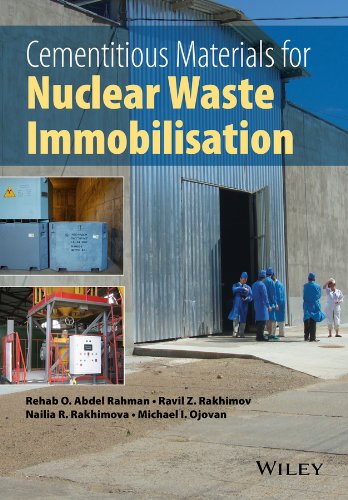

Most ebook files are in PDF format, so you can easily read them using various software such as Foxit Reader or directly on the Google Chrome browser.
Some ebook files are released by publishers in other formats such as .awz, .mobi, .epub, .fb2, etc. You may need to install specific software to read these formats on mobile/PC, such as Calibre.
Please read the tutorial at this link. https://ebooknice.com/page/post?id=faq
We offer FREE conversion to the popular formats you request; however, this may take some time. Therefore, right after payment, please email us, and we will try to provide the service as quickly as possible.
For some exceptional file formats or broken links (if any), please refrain from opening any disputes. Instead, email us first, and we will try to assist within a maximum of 6 hours.
EbookNice Team

Status:
Available4.6
39 reviews
ISBN-10 : 1118512006
ISBN-13 : 9781118512005
Author: Rehab O. Abdel Rahman, Ravil Z. Rakhimov, Nailia R. Rakhimova, Michael I. Ojovan
Cementitious materials are an essential part in any radioactive waste disposal facility. Conditioning processes such as cementation are used to convert waste into a stable solid form that is insoluble and will prevent dispersion to the surrounding environment. It is incredibly important to understand the long-term behavior of these materials. This book summarises approaches and current practices in use of cementitious materials for nuclear waste immobilisation. It gives a unique description of the most important aspects of cements as nuclear waste forms: starting with a description of wastes, analyzing the cementitious systems used for immobilization and describing the technologies used, and ending with analysis of cementitious waste forms and their long term behavior in an envisaged disposal environment. Extensive research has been devoted to study the feasibility of using cement or cement based materials in immobilizing and solidifying different radioactive wastes. However, these research results are scattered. This work provides the reader with both the science and technology of the immobilization process, and the cementitious materials used to immobilize nuclear waste. It summarizes current knowledge in the field, and highlights important areas that need more investigation. The chapters include: Introduction, Portland cement, Alternative cements, Cement characterization and testing, Radioactive waste cementation, Waste cementation technology, Cementitious wasteform durability and performance assessment.
1 Introduction
1.1 Background of Nuclear Waste Problem
1.2 Nuclear Industry Facilities
1.3 Nuclear Waste Sources and Classification
1.4 Nuclear Waste Management
1.5 Wasteform Materials
References
2 Cements
2.1 Cements
2.2 Portland Cement: Manufacture, Mineral Composition, Properties
2.3 Phase and Mineral Composition of Ordinary Portland Cement
2.4 Properties of Portland Cement
2.5 Hydration of Portland Cement
2.6 Interaction of Portland Cements with Water and Soil
References
3 Portland Cements with Mineral and Chemical Admixtures
3.1 Chemical Admixtures to Control the Structure and Properties of Portland Cements
3.2 Mineral Admixtures in the Control of the Composition, Structure and Properties of Cements
References
4 Alternative Binders
4.1 Calcium Aluminate Cements
4.2 Calcium Sulphoaluminate Cements
4.3 Phosphate Cements
4.4 Alkali-Activated Cements
References
5 Cement Properties, Characterization and Testing
5.1 Water/Cement Ratio, Water Requirement, Workability and Water Retention
5.2 Setting Time
5.3 Specific Surface Area and Particle Size Distribution
5.4 Heat Evolution
5.5 Strength
5.6 Freeze–Thaw Resistance
5.7 Microstructure and Analysis
References
6 Radioactive Waste Cementation
6.1 Radioactive Waste Streams for Cementation
6.2 Liquid Waste
6.3 Bulk Solid Radioactive Wastes
6.4 Fragmented (Dispersed) Solid Wastes
6.5 Additives for Radioactive Waste Cementation
6.6 Cement-Based Composite Materials
6.7 Cement-Based Wasteform Optimization
References
7 Waste Cementation Technology
7.1 Methods of Liquid Waste Cementation
7.2 Methods for Cementation of Fragmented (Dispersed) Solid Waste
7.3 Methods for Cementation of Bulk Solid Waste
7.4 Quality Control of Technological Processes and Materials Obtained
References
8 Cementitious Wasteform Durability
8.1 Wasteform Durability Requirements
8.2 Role of Material Performance
8.3 Expected Performance of Cements
8.4 Wasteform Leaching Parameters
8.5 Laboratory Tests
8.6 Long-Term Field Tests
8.7 Effect of Radiation
8.8 Biological Effects
8.9 Role of Filling Materials
References
9 Performance Assessment
9.1 Historical Disposal Practice
9.2 Disposal Facility Design
9.3 Modelling Approaches
9.4 Performance Assessment
9.5 Safety Case
References
10 Future Trends and Concluding Remarks
10.1 Role of Cementitious Materials
10.2 Novel Cementitious Materials
10.3 Concluding Remarks
what is nuclear waste made of
composition of nuclear waste
what is radioactive waste made of
what elements are in nuclear waste
cement-based materials for nuclear waste storage
Tags: Cementitious, Materials, Nuclear, Waste Immobilization, Rehab Abdel Rahman, Ravil Rakhimov, Nailia Rakhimova, Michael Ojovan